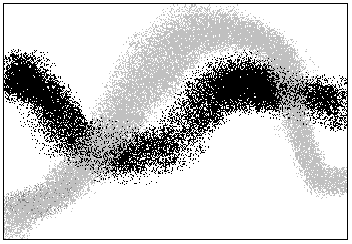2.4 Controlling
textures of grains
When granular
synthesis is heard it becomes a texture rather than a series of grains
(Zadorin 1997). This is a phenomenon that humans have experienced in many
different ways since the beginning of time. A prime example of this is
a pine tree. The pine needles are very small. When looking at a pine tree,
all that is really visualised is a green mass, or on the ground all that
is seen is a golden mass. The needles are still there, and they can be
explored as such, but they create a texture which is more relevant to the
human senses. Whilst one can analyse the grains in a granulated sound,
the impression one receives is the texture.
This idea
of a controllable texture is a new way of considering music. Granular synthesis
provides the means to precisely control multidimensional parameters, and
therefore control the entire texture. It is unique in the way it creates
a bridge between the micro and macro level. The micro-grain is a trivial
insignificant sound object, but with the implementation of higher level
structures it becomes a sound texture on the macro level (Truax 1990: 123).
The micro level consists of lower control levels, the contents and the
envelope of an individual grain. The macro level of control deals with
higher level parameters to control the flow of grains, and to give the
grains some kind of cohesion within the texture.
A number
of control parameters have already been discussed, that is, the micro level
controllers, but there are still more parameters to consider. It is apparent
that, whilst it is good to be able to control so much information, it is
becoming increasingly more difficult because of the sheer number of events,
especially if there are over a thousand grains being processed per second.
One way
to overcome this problem is to use algorithms to control different parameters.
This could be achieved by setting an upper limit and a lower limit and
commanding the computer to select random elements within the prescribed
field.
Another
method used is statistical determination algorithms. The most common algorithm
in granular synthesis has been stochastic determination.1
Iannis Xenakis spoke about this method in great detail in his book
Formalized
Music (Xenakis 1971). The very first granular synthesis composition
Analogique
A-B written by Xenakis in 1958-1959 uses this method. This composition
will be discussed in more detail in chapter 4. The fundamental principle
behind stochastic determination is an asymptotic evolution towards some
goal2
(Xenakis 1971: 4). The goal is reached through an iterative process, which
will finally stabilise around a certain point. The teleological nature
of stochastic determination makes it useful for giving granular textures
some direction or point.
Another distribution method is Poisson distribution.3 The fundamental principle behind this method is that it is not a continuous distribution, but it is limited within certain fields. Truax devised a computer program POD that uses this method of distribution. POD has been updated many times as computer technology has improved. POD uses an idea of tendency masks. Using the theory of Poisson distribution being limited between different values, the tendency mask is made of a lower limit and and upper limit. This can be set up as a graphical representation of the limits (Truax 1988: 19). The tendency masks consist of the different parameters that will be using the Poisson distribution method. Figure 2.8 shows the Tendency mask used in Truax's piece 'The wings of Nike'.

Fig 2.8: Tendency mask for Wings of Nike (Truax 1990: 128)
Tendency
masks are useful because they are simply understood and much more compact
than a list of numbers. POD allows the parameters of the tendency mask
to be manipulated in a real-time environment by pressing set keys on the
keyboard whilst the mask is being synthesised (Dodge & Jerse 1997:
275). This allows the composer to react to the texture produced. The piece
Riverrun
which is analysed in chapter 4, makes use of tendency masks.
So far all
the methods involve a single group of grains. These populations of grains
have a single identity, in that they create a single layered texture.
Streams
are an important addition if multiple layered textures are desired. Streams
are a way of labelling the different groups of grains. They can be used
to manage multiple sets of grain populations. (McAdams & Bregman 1979:
26)
Streams
can be achieved by recording through different channels and then mixing
down together, however there is less interaction between the streams. Streams
can usually be easily followed in granular synthesis. They can be thought
of as the harmonies of the texture. Streams usually have some kind of relationship,
for example, stream1 could consist of grains created with sound sample1,
and stream2 could consist of grains created with sound sample2. See figure
2.9.
| ^
^ Y |
 |
| X >> |
Fig 2.9:
Two streams. It has two layers within the one texture.